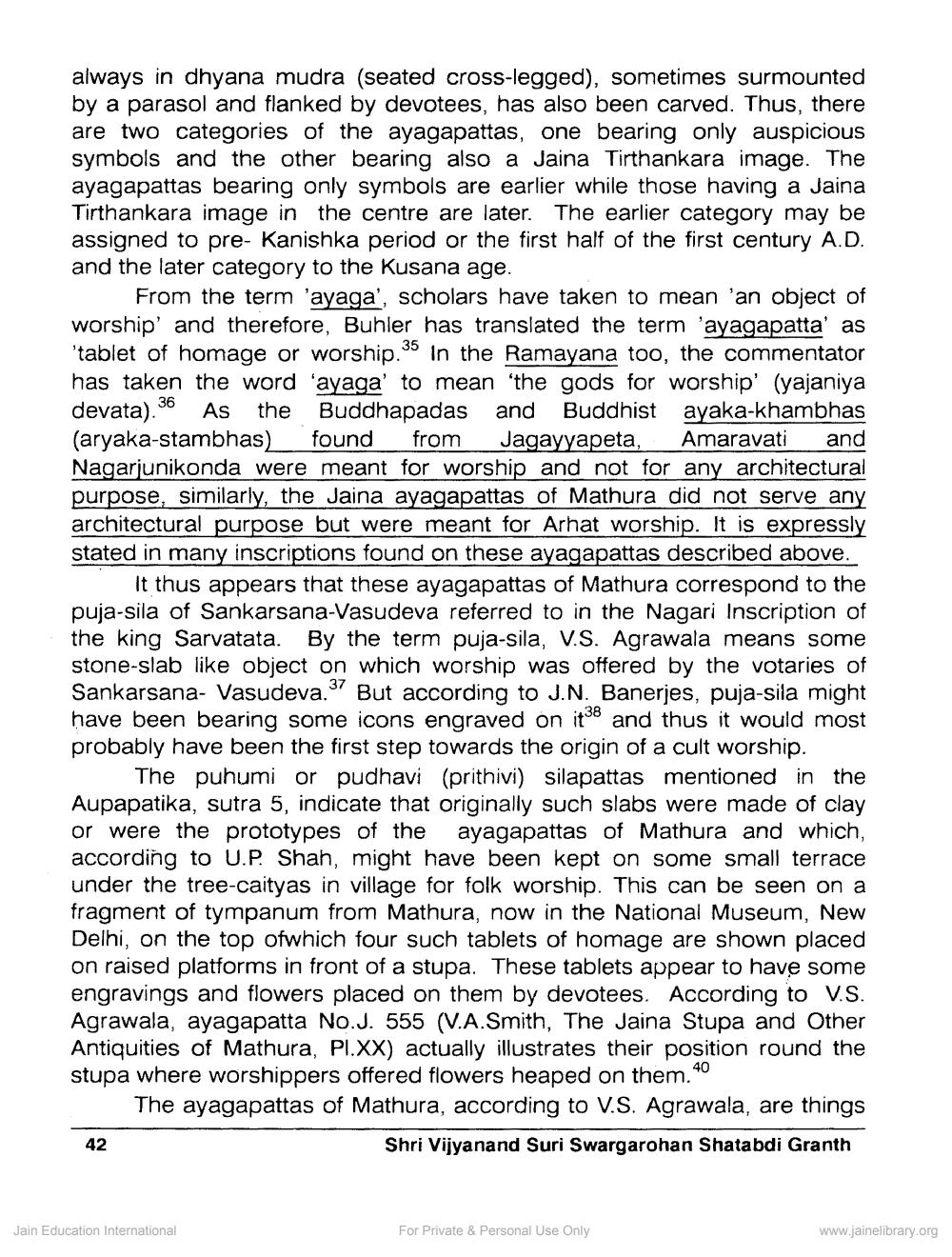Book Title: Ayag Patta and the beginning of Jain Cult Workship Author(s): A L Srivastava Publisher: Z_Vijyanandsuri_Swargarohan_Shatabdi_Granth_012023.pdf View full book textPage 7
________________ always in dhyana mudra (seated cross-legged), sometimes surmounted by a parasol and flanked by devotees, has also been carved. Thus, there are two categories of the ayagapattas, one bearing only auspicious symbols and the other bearing also a Jaina Tirthankara image. The ayagapattas bearing only symbols are earlier while those having a Jaina Tirthankara image in the centre are later. The earlier category may be assigned to pre- Kanishka period or the first half of the first century A.D. and the later category to the Kusana age. From the term 'ayaga', scholars have taken to mean 'an object of worship and therefore, Buhler has translated the term 'ayagapatta' as 'tablet of homage or worship. In the Ramayana too, the commentator has taken the word 'ayaga' to mean the gods for worship (yajaniya devata). 56 As the Buddhapadas and Buddhist ayaka-khambhas (aryaka-stambhas found from Jagayyapeta, Amaravati and Nagarjunikonda were meant for worship and not for any architectural purpose, similarly, the Jaina ayagapattas of Mathura did not serve any architectural purpose but were meant for Arhat worship. It is expressly stated in many inscriptions found on these ayagapattas described above. It thus appears that these ayagapattas of Mathura correspond to the puja-sila of Sankarsana-Vasudeva referred to in the Nagari Inscription of the king Sarvatata. By the term puja-sila, V.S. Agrawala means some stone-slab like object on which worship was offered by the votaries of Sankarsana- Vasudeva." But according to J.N. Banerjes, puja-sila might have been bearing some icons engraved on it and thus it would most probably have been the first step towards the origin of a cult worship. The puhumi or pudhavi (prithivi) silapattas mentioned in the Aupapatika, sutra 5, indicate that originally such slabs were made of clay or were the prototypes of the ayagapattas of Mathura and which, according to U.P. Shah, might have been kept on some small terrace under the tree-caityas in village for folk worship. This can be seen on a fragment of tympanum from Mathura, now in the National Museum, New Delhi, on the top ofwhich four such tablets of homage are shown placed on raised platforms in front of a stupa. These tablets appear to have some engravings and flowers placed on them by devotees. According to V.S. Agrawala, ayagapatta No.J. 555 (V.A.Smith, The Jaina Stupa and Other Antiquities of Mathura, PI.XX) actually illustrates their position round the stupa where worshippers offered flowers heaped on them.' The ayagapattas of Mathura, according to V.S. Agrawala, are things 42 Shri Vijyanand Suri Swargarohan Shatabdi Granth Jain Education International For Private & Personal Use Only www.jainelibrary.orgPage Navigation
1 ... 5 6 7 8 9 10
